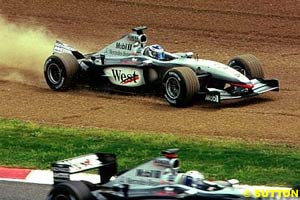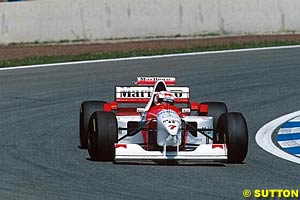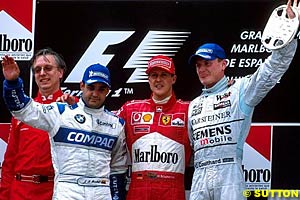
Atlas F1 Magazine Writer
What record can Kimi Raikkonen break in Spain? What happened to Nigel Mansell at Barcelona the last time he drove in Formula One? And what drivers are expected to perform well this weekend, based on their past performances? Marcel Schot brings the answers and more anecdotes on the fifth Grand Prix of the 2003 season
As far as the Spanish Grand Prix is concerned, the odds are on Schumacher again. The German has won the race four times, scored nine podiums and leads just about every statistical category you can think of.
Nevertheless, Raikkonen can set a new record this weekend: should he score another podium finish, he'll be the only driver to have done so nine times before his 24th birthday. The current record - of eight - is shared by Raikkonen, Michael Schumacher and Bruce McLaren, quite a promising group to belong to.
Looking at the exact age of Raikkonen on the day of the San Marino Grand Prix (23 years, 6 months and 3 days) and what other drivers had performed by then, we see at what exceptional rate Raikkonen's career is progressing at the moment:
Bruce McLaren is the only driver to have won twice before he was Raikkonen's age, and Troy Ruttman was the only other driver to have won a race at all.
Another McLaren driver has a less pleasant memory of the Spanish Grand Prix. On February 3rd 1995 McLaren announced their number one driver for the upcoming season would be none other than Nigel Mansell. However, it took a while before Mansell finally boarded the car.
The Spanish Grand Prix was a different story, though. On Friday Mansell was outqualified by his teammate Mika Hakkinen by a massive 1.8 seconds. According to the Briton, his car suffered from major over- and understeer. On Saturday things went better, with Mansell only just behind Hakkinen, but ninth and tenth on the grid wasn't really what the team had hoped for.
On Sunday, Mansell had quite a horrible start as he dropped from tenth to 15th. However, 'Lionheart' still had his fighting spirit and soon made his way past Olivier Panis and Ukyo Katayama. The first stop went on as scheduled, but after that the car suddenly became undriveable. After 18 laps, Mansell steered into the pits and that was it for the World Champion's Formula One career.
Nine days after the Spanish Grand Prix it was announced that Mansell and McLaren would part ways. McLaren boss Ron Dennis commented: "The performance of the 1995 Formula One car, MP4/10, has not met the expectations of both parties so far this year. Nigel has not felt confident within the car, and this has affected his ability to commit fully to the programme. In these circumstances, I believe that we have determined the most appropriate course of action. The relationship has been short, and has obviously not achieved the results anticipated by either party."
Meanwhile, Mansell said: "I am obviously disappointed that the relationship with McLaren and Mercedes, which could have achieved so much, has been concluded early. At this stage of my career I had expected, on joining McLaren, that the total package would have given me the possibility to be competitive with the other top teams." It was Mansell's final goodbye from Formula One.
While on the subject of temperamental drivers, there's one who does particularly well in Spain: Juan Pablo Montoya. In his two races in Barcelona he came second to Michael Schumacher, the race in 2001 being his first ever Formula One podium finish.
On Sunday, Montoya's start was spectacular. While David Coulthard dropped down, the Colombian took a clean route through the center and was up to seventh before the first corner. Entering the first corner, he beat Jacques Villeneuve for sixth, where he settled until the pitstops. The Williams team did a good job to bring Montoya out in fourth, ahead of Villeneuve, Trulli and Heidfeld.
The second stop made no change, but shortly after that the rear suspension of Rubens Barrichello failed and Montoya moved into third. With no real threat from Villeneuve, Montoya brought the car home. And, when Mika Hakkinen's leading McLaren cruised to a halt on the final lap, a second position was merely a nice bonus for Montoya.
With Michael Schumacher winning the San Marino Grand Prix, we now have had four different winners in the first four races of the season. This had not happened since 1983, when Nelson Piquet, John Watson, Alain Prost and Patrick Tambay were the winners in the opening rounds of the season. The first half of that season delivered no less than seven winners in eight races.
 However, Kimi Raikkonen is still the man to beat this season. With four successive podium finishes, confidence is high for the Finn. On the other hand, Kimi didn't do too well in his previous two Spanish Grands Prix. Last year the race had barely started when Raikkonen's McLaren suddenly lost its rear wing on the start-finish straight. Likewise, in his debut year at Sauber, the pace was there in qualifying, but in the race the car simply lacked speed. Eighth place was the result, some 15 seconds behind Olivier Panis and 18 seconds behind teammate Nick Heidfeld.
However, Kimi Raikkonen is still the man to beat this season. With four successive podium finishes, confidence is high for the Finn. On the other hand, Kimi didn't do too well in his previous two Spanish Grands Prix. Last year the race had barely started when Raikkonen's McLaren suddenly lost its rear wing on the start-finish straight. Likewise, in his debut year at Sauber, the pace was there in qualifying, but in the race the car simply lacked speed. Eighth place was the result, some 15 seconds behind Olivier Panis and 18 seconds behind teammate Nick Heidfeld.
Driver Podiums
================== =======
Bruce McLaren 8
Kimi Raikkonen 8
Michael Schumacher 4
Ralf Schumacher 3
Rubens Barrichello 2
Jos Verstappen 2
Fernando Alonso 2
Troy Ruttman 1
Mike Hawthorn 1
Jacky Ickx 1
Elio de Angelis 1
David Coulthard 1
Cesare Perdisa 1
Andrea de Cesaris 1
Alexander Wurz 1
 As the car was designed before Mansell joined the team in the first place, it soon became clear that the Briton could not sit in the car comfortably. The result was that the team had to design a chassis to fit Mansell and that Mark Blundell would drive the first two races of the season. Mansell made his debut with the team at Imola, finishing the race in tenth place after requiring two pitstops within a few laps of each other while running fifth.
As the car was designed before Mansell joined the team in the first place, it soon became clear that the Briton could not sit in the car comfortably. The result was that the team had to design a chassis to fit Mansell and that Mark Blundell would drive the first two races of the season. Mansell made his debut with the team at Imola, finishing the race in tenth place after requiring two pitstops within a few laps of each other while running fifth.
 As the weekend began, the Williams team was struggling to get the setup right and both drivers weren't on the pace at all. Ralf Schumacher finished the day eighth, a full second behind leader David Coulthard. For Montoya things were worse, since he managed only a 13th place, nearly two seconds behind the leader. Both drivers went better on saturday morning, but so did everyone else. When qualifying arrived, things hadn't improved much and especially Montoya wasn't helped with traffic in his final two runs. The end result was a 12th position on the grid.
As the weekend began, the Williams team was struggling to get the setup right and both drivers weren't on the pace at all. Ralf Schumacher finished the day eighth, a full second behind leader David Coulthard. For Montoya things were worse, since he managed only a 13th place, nearly two seconds behind the leader. Both drivers went better on saturday morning, but so did everyone else. When qualifying arrived, things hadn't improved much and especially Montoya wasn't helped with traffic in his final two runs. The end result was a 12th position on the grid.
|
Volume 9, Issue 18
Atlas F1 Exclusive
Exclusive Interview with Mark Webber
The Coming Man
Articles
Season in the Sun
2003 Spanish GP Preview
2003 Spanish GP Preview
Spanish GP Facts & Stats
Columns
The Fuel Stop
The F1 Trivia Quiz
Bookworm Critique
On the Road
Elsewhere in Racing
The Weekly Grapevine
> Homepage |